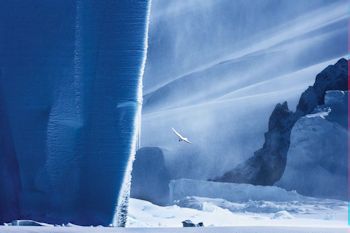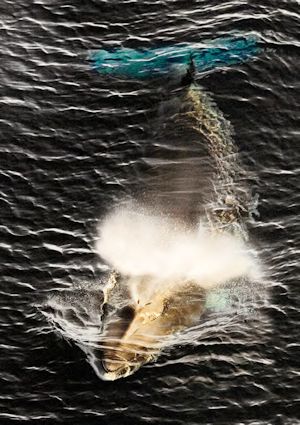SEJournal Online is the digital news magazine of the Society of Environmental Journalists. Learn more about SEJournal Online, including submission, subscription and advertising information.
Between the Lines
 |
|
The Ross Sea landscape is a synthesis of fire and ice. A series of volcanoes extends from the southwestern corner of the Ross Sea in a north-south line. Extinct domes (right) rise high above the water to form the black rock cliffs of Beaufort and Franklin Islands. |
Like many outdoor and nature photographers before him, John Weller, author of the recently released “The Last Ocean: Antarctica’s Ross Sea Project” (Rizzoli, $50; see review on p. 18 or online here), has embraced the belief that the camera can serve as a powerful tool to advance environmental protection. But unlike many of his current and past colleagues, his efforts aren’t limited solely to the production of pictures, but rather to using his photography, writing and media to promote marine conservation around the world.
Shortly before departing for Indonesia on his most recent project, which will focus on protecting marine diversity in the Raja Ampat Islands, Weller spoke to SEJournal photo editor Roger Archibald and offered insights about how a Stanford economics major contemplating an academic career evolved into a global advocate for marine conservation with interests stretching from the tropics to the poles.
[See more of John Weller's Ross Sea photos here, beginning on page 12.]
SEJournal: Describe your journey from your first encounter with a camera to where you are today.
Weller: I started taking photographs when I was four years old at my sister’s first birthday party, and somehow it suited me. That became my passion all the way up through college. But I was basically having my mid-life crisis when I was 22 years old. I was really thinking about photography, and how much I absolutely loved that medium. At that point, I made a decision to move into photographythat was not lightly taken, but I made a single call to [photographer] William Neil in Yosemite and started a conversation with him. I ended up as his apprentice for the next two years, and learned the ropes in the Yosemite area.
What brought me back to Boulder was the chance to exhibit my work at NCAR [National Center of Atmospheric Research]. The right person walked past that show and bought an outrageous number of prints. The sale was worth enough to float me for two years, which was amazing. And so I bade adieu to Bill [Neil] in Yosemite, and I moved back home into my parents’ basement to extend my money.
During the next three years, I produced the Sand Dunes book (“Great Sand Dunes National Park: Between Light and Shadow,” Westcliff, 2004). So I was hiking out for a week at a time by myself into the wilderness to photograph every month for three years. It was a wonderful experience and I got some very beautiful imagery. But what was happening behind the scenes was a very analogous situation as in the Ross Sea. A developer had bought a big chunk of land, and was going to pump all the water out from under it up to Denver. Of course, the dunes system is completely dependent on that aquifer. And what ensued was this movement in the San Luis Valley to protect the dunes. The real drivers were the ranchers who realized conservation was a means to an end. For them, it wasn’t about protecting a pretty dune system, it was about protecting the San Luis aquifer. And what that showed me was conservation in that situation was not a luxury, but a human necessity. This place was worth more alive than dead. And I wanted to tell that story.
SEJournal: At one point you planned to get an economics Ph.D. Did you find economics to be something really helpful in understanding ecosystems?
Weller: Aside from continually informing me exactly how broke I am, economics has been very useful as a tool to look at understanding how humans interact with ecosystems. That’s really where the meat of this work lies. We’re trying to change human behavior. And that’s what we need to do if we’re going to protect the resources that we have left.
I was impassioned by economics to a large extent because of one particular precept of economics: You can prove that conservation is efficient. That kind of flies in the face of the way that we think about economics and environment, where it’s very often presented as a trade-off — either you protect your environment or you maintain your economy. And in the long run that’s not at all true. That’s something that I really connect with in economics, and it was in part responsible for the path that I’ve taken.
SEJournal: What was your initial impetus to embark on the Ross Sea project?
Weller: I wanted to tell the Sand Dunes story again, and I was looking around for a place to tell that story. A friend of mine from high school who had been working in Antarctica came through town in 2004, and when I met her, she literally thrust this paper into my hands. And she said, “You have to read this right now. This is a story everybody needs to know. This is the last pristine ecosystem.” It was a very obscure scientific paper about the Ross Sea by (ecologist) David Ainley. Basically, he lays out the Ross Sea story. It’s this last intact place; it’s being threatened by a fishery that’s expanding.
 |
|
A misty cloud drifts across the ice when a Minke whale breaks the surface, exhaling a salty spray and then filling its huge lungs with another breath. These whales follow the seams and breaks in the pack ice, finding pockets of water to feed on phytoplankton and tiny shrimp-like krill. |
And it kept me up at night, this idea that there was one place left in the entire ocean. I couldn’t sleep, and I ended up calling this ecologist and flying out to meet him in California. We committed to try to tell the story. He sent me home with an armful of reading material to start building my knowledge about the area. Then I started to work on getting money to do the work. It took me thousands of phone calls to start this project off. The scientists didn’t bring money to the project. I brought money to the scientists. So actually a fair amount of the fundraising was not for the photography, it was about organizing the scientists. Because the purpose of the project was to highlight the Ross Sea and promote protection, it turned out that in many cases, photography was not the right tool for the moment, and so I would engage in other parts of the process. I was able to find funding to bring everybody to the International Marine Conservation Congress in Baltimore [in 2009], and run a symposium on the Ross Sea. I’m really proud of that part of the work. Nobody had ever collated all of the different scientific angles so that you could look at the problems and really give an estimate of the Ross Sea. That was a really useful piece of work, and didn’t really have anything to do with the photography.
The Ross Sea project cost something like a million dollars to do all those trips. For months on end I literally would kind of wander around my backyard, pacing with my cell phone, trying to think, ‘Who do I call next?’ I cold-called the manager of [tour operator] Quark Expeditions, and basically asked him, ‘Hey, can you take me to the Ross Sea?’And sure enough, he gave me passage on several different ships. Most of that money was collected through private donors. I got a fiscal sponsorship through SeaWeb to collect money as a 501(c)(3). And I was able to fund the project. We were not eating filet mignon on the road, but we were able to get the photography done.
SEJournal: Did having the Great Sand Dunes book in print make a big difference in your later efforts to promote your Ross Sea project?
Weller: That was definitely a key, like a calling card, and I could say, “Look, this is what I did in the Great Sand Dunes; here’s what I want to do in Antarctica.” Without that book, I wouldn’t have gotten the support, for sure. Having the support of the scientific community was also key in opening the first doors. But the real meat of Quark’s support came not in any way because I was a great photographer, but because I had a great story. So I think that photographers who are looking to do good work, if you have the right story, and you have the right content partners — because by that time I had a team of biologists that were acting as my mentors in trying to tell this story — once you have your brain trust in place, and you have a legitimate story to tell, you’re in good shape.
SEJournal: Has writing been as important as photography in getting your conservation message out?
Weller: It’s definitely equally as important, if not more so. For the most part, you need interpretation, you need words around the photograph to maintain context and to tell a deeper story. Where I was able to separate myself a little bit and maybe bypass some of the complexity of working as a photographer and having to make a living and pursue these projects, is that I was able to write. I’d say that my main activity is writing, and developing a project and then writing grants to try to support it. Most of the funding has come through foundations like the Pew Fellowship [which was] three years’worth of money. I have another fellowship actually — it just started — with the Blue Ocean Institute, Carl Safina’s group in New York. He’s done me the honor of giving me a fellowship to pursue work in Indonesia.
SEJournal: Do you have a particular target audience that you’re trying to reach with this book?
Weller: Absolutely. We’ve been trying to find every creative angle we can to enter into the political process with the arts and with the messaging, and trying to get this in front of the right crowd. And there are really two audiences that we’re trying to reach: obviously the political powers that are in charge of deciding whether the Ross Sea is going to be protected or not — that was our first big audience — but then one of the reasons (and I’m still convinced of this) is that people care about these things if they know about them. The main issue in our society is that people don’t know what the real issues are, and so they can’t act on them. So getting the message to the public, and getting a broader understanding of the value of these areas, these last pristine places, that’s a very pertinent thing for me.
* From the quarterly newsletter SEJournal, Spring 2014. Each new issue of SEJournal is available to members and subscribers only; find subscription information here or learn how to join SEJ. Past issues are archived for the public here.












 Advertisement
Advertisement 



